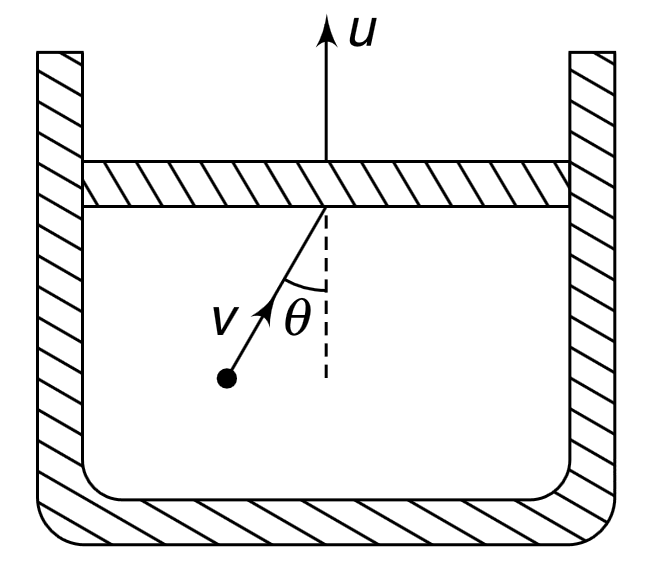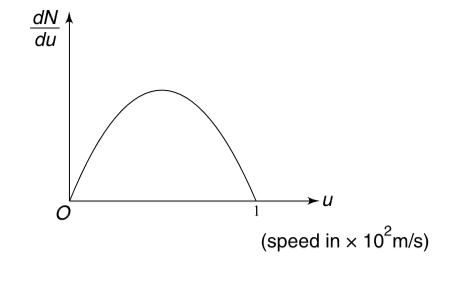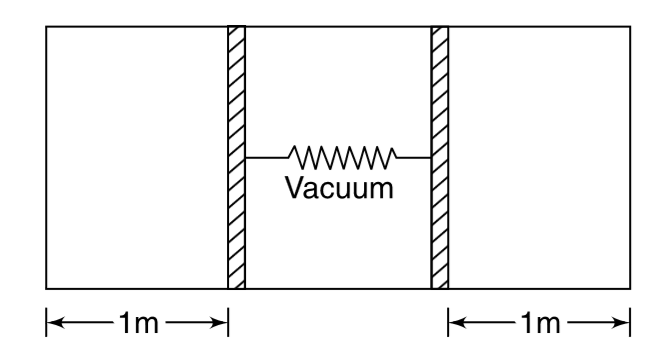Complete Solutions to Level 3 of chapter KINETIC THEORY OF GASES of Class 11 book with complete answers and questions
| Class 11 | PHYSICS |
| Chapter | KINETIC THEORY OF GASES |
| ARIHANT MASTER PROBLEM | Level 3 |
| Number Of Questions | 4 |
| Academic Year | 2023-24 |
An ideal gas is inside a cylinder with a piston that can move freely. The walls of the cylinder and piston are non- conducting. The piston is being moved out of the cyl- inder at a constant speed u.
(a) Consider a gas molecule of mass m moving with speed `v (gt gt u)`. It hits the piston elastically at an angle of incidence q. Calculate the loss in kinetic energy of the molecule.
(b) If the area of piston is A and pressure of the gas is P, calculate the rate of decreases of molecular kinetic energy of the gas sample.
(c) If` u gt gt` molecular velocities, at what rate will the gas lose its molecular kinetic energy
 06:22View Solution
06:22View SolutionThe speed distribution of molecules in a sample of a gas is shown in the figure. The graph between `(dN)/(du)` and u is a parabola and total number of molecules in the sample is `N_(0)`.
(a) Calculate the rms speed of the molecules.
(b) Calculate the total translational kinetic energy of molecules if mass of the sample is 10 g.
 06:40View Solution
06:40View SolutionA cylindrical container is divided into three parts by two tight fitting pistons. The pistons are connected by a spring. The region between the pistons is vacuum and the other two parts have same number of moles of an ideal gas. Initially, both the gas chambers are at temperature `T_(0)` and the spring is compressed by 1 m. Length of both gas chambers is 1 m in this position. Now the temperature of the left and right chambers are raised to `(4T_(0))/(3)` and `(5T_(0))/(3)` respectively. Find the final compression in the spring in equilibrium. Assume that the pistons slide without friction
 10:02View Solution
10:02View SolutionA helium balloon has its rubber envelope of weight `w_("Rubber")` and its is used to lift a weight of `w_("Load")`. The volume of fully inflated balloon is `V_(0)`. The atmospheric temperature is `T_(0)` throughout and the atmospheric pressure is known to change with height y according to equation `P = P_(0) e^( – ky)` where k is a positive constant and `P_(0)` is atmospheric pres- sure at ground level. The balloon is inflated with sufficient amount of helium so that the net upward force on is `F_(0)` at the ground level. Assume that pressure inside the balloon is always equal to the outside atmospheric pressure. Density of air and helium at ground level is `rho_(a)` and `rho_(He)` respectively.
(a) Find the number of moles (n) of the helium in the balloon.
For following two questions assume n to be a known quantity.
(b) Find the height `(y(0))` at which the balloon is fully inflated.
(c) Prove that the balloon will be able to rise to height `y_(0)` if `(nRT_(0)g)/(P_(0))(rho_(a)-rho_(Hg)) gt w_("Rubber"+w_("Load")`View Solution
Level 3 questions and complete solutions for chapter KINETIC THEORY OF GASES of ARIHANT PHYSICS (HINGLISH) of Class 11
